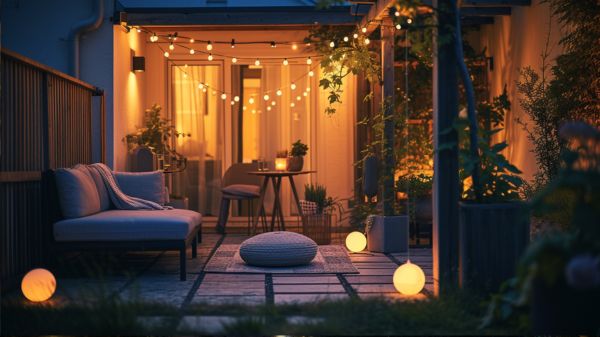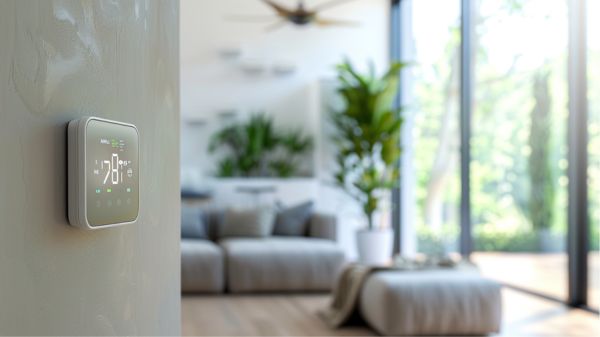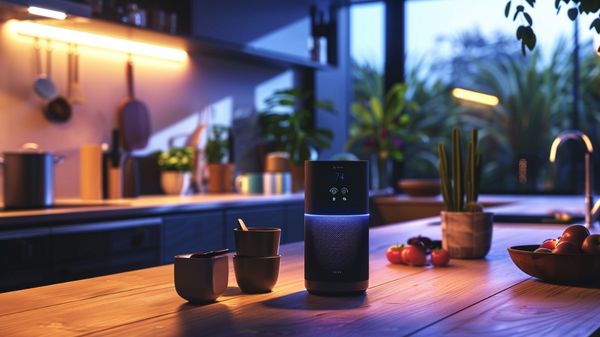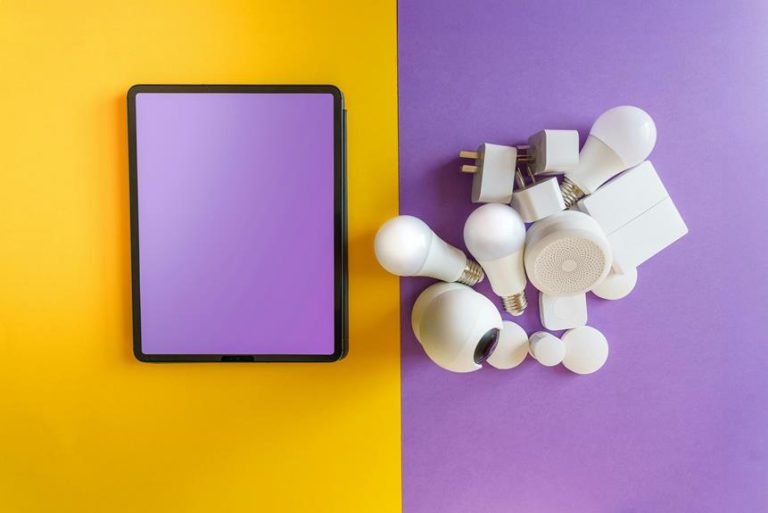Opting for energy-efficient lighting in homes is not simply a fad but a strategic shift towards saving costs and environmental stewardship. With lighting constituting about 15% of a household’s energy consumption, the shift to energy-conserving bulbs like LEDs, CFLs, and Halogen incandescent bulbs offers a significant chance for financial and ecological advantages.
These contemporary lighting solutions provide substantial decreases in electricity expenses and a reduction in carbon footprints. However, the benefits go beyond just financial savings and environmental effects. What other advantages might homeowners experience by making this change?
Key Takeaways
- Energy-efficient lighting can reduce household electricity costs by approximately $225 annually.
- LED bulbs use up to 90% less energy and last up to 25 times longer than incandescent bulbs.
- Energy-efficient lighting significantly reduces the environmental impact and carbon footprint.
- LED lighting offers instant full brightness and versatile design options for various lighting needs.
- Integrating energy-saving controls like timers and dimmers with LED bulbs maximizes energy conservation and savings.
Benefits of Energy-Efficient Lighting
Adopting energy-efficient lighting solutions, such as LED bulbs, can reduce household electricity costs by about $225 annually while also decreasing the environmental impact. Lighting accounts for approximately 15% of a typical home’s electricity consumption, highlighting the importance of making energy-efficient choices to curtail energy bills effectively.
LED lighting stands at the forefront of energy-efficient technology, offering significant financial and environmental benefits. LEDs not only use substantially less energy than traditional incandescent bulbs but also boast a lifespan up to 25 times longer. This longevity translates to fewer replacements over time, thereby further driving down costs associated with lighting maintenance and purchases.
In addition to their cost-saving advantages, LEDs provide superior quality of light, enhancing the ambiance and functionality of living spaces. The immediate switch to full brightness, coupled with the absence of flicker, makes LEDs a preferable choice for creating comfortable and productive environments.
Moreover, integrating energy-saving controls, such as timers and dimmers, can optimize the usage of energy-efficient lighting, ensuring light is only used when necessary and at the desired intensity. Consequently, adopting energy-efficient lighting practices liberates households from high energy bills and contributes to a more sustainable future.
Types of Energy-Saving Bulbs
Exploring the types of energy-saving bulbs reveals a range of options including LED, CFL, and Halogen incandescent bulbs, each designed to minimize electricity consumption and enhance sustainability.
LED bulbs, known for their exceptional efficiency, consume significantly less energy and offer unparalleled longevity, lasting up to 50 times longer than traditional incandescent bulbs. This makes LEDs a premier choice for those seeking efficient and longer-lasting lighting solutions.
CFL (Compact Fluorescent Lamp) bulbs also present an energy-saving alternative. These bulbs use around 70% less energy than incandescent bulbs and have a lifespan several times longer. However, while CFLs are more efficient than their incandescent counterparts, they fall short of LEDs in terms of flexibility and overall efficiency.
Halogen incandescent bulbs, though more efficient than traditional incandescent bulbs, still consume more energy than LEDs and CFLs. They serve as an interim technology, offering improved efficiency and a longer lifespan compared to traditional incandescent bulbs but are not as efficient or long-lasting as LEDs.
To determine the most suitable option for a home’s lighting needs, consulting a reputable Nassau County electrician (or one elsewhere) can often be highly beneficial. A professional can evaluate the existing setup, recommend the most efficient bulb types, and ensure that fixtures and wiring are compatible with the chosen lighting technology.
LED Technology Advantages
LED technology stands out as the pinnacle of energy-efficient lighting, offering up to 90% energy savings compared to traditional incandescent bulbs. This efficiency translates into substantial reductions in household energy consumption and utility bills.
LEDs, as energy-efficient bulbs, are designed to use considerably less energy while providing the same, if not better, quality of light. Their ability to achieve full brightness instantly without any warm-up time further enhances their appeal.
Moreover, LEDs have an impressive lifespan, lasting up to 25 times longer than their incandescent counterparts. This longevity not only reduces the frequency of replacements but also minimizes waste, aligning with sustainable living practices. Available in various types, LEDs can meet diverse lighting requirements, such as ambient lighting for living spaces or task lighting for work areas.
The dimmable feature of LED lighting allows homeowners to adjust light levels to their preference, contributing to additional energy savings and customized comfort. Suitable for both indoor and outdoor applications, LEDs provide a versatile solution that adapts to different environmental conditions while maintaining low energy consumption.
Embracing LED technology offers an opportunity to enhance home lighting efficiency, reduce environmental impact, and achieve a more sustainable lifestyle.
Energy-Saving Controls
Integrating energy-saving controls such as timers and dimmers with energy-efficient lighting solutions can greatly enhance household energy conservation and sustainability. Timers play a vital role in automating the switching off of lights when they are not needed, thereby maximizing electricity usage. For example, a study by the U.S. Department of Energy highlighted that timers could reduce lighting energy consumption by up to 20%.
Dimmers provide the flexibility to adjust the brightness of LED lights, which can lead to significant energy savings. By lowering the light levels, dimmers extend the lifespan of energy-efficient bulbs and reduce power consumption. Research indicates that dimming lights by 50% can potentially save approximately 40% in energy usage.
To maximize the benefits, it is essential to choose energy-efficient bulbs that are compatible with these controls. LED lights, known for their long lifespan and low energy use, are often designed to work seamlessly with both timers and dimmers, ensuring optimal efficiency.
Homeowners looking to enhance their energy conservation efforts should prioritize products that integrate well with energy-saving controls, thereby achieving a sustainable and liberated living environment. This strategic combination not only lowers energy bills but also contributes to a greener planet.
Outdoor Lighting Efficiency
Maximizing outdoor lighting effectiveness involves choosing energy-saving options like LEDs or CFLs, recognized for their durability and ability to withstand harsh weather conditions. LEDs and CFLs are designed to offer significant energy savings while maintaining performance in environments exposed to rain and snow. For those seeking to optimize their outdoor lighting solutions, these choices are essential.
To further enhance outdoor lighting effectiveness, consider the following strategies:
- Select ENERGY STAR-certified fixtures: These fixtures ensure superior energy efficiency and performance, guaranteeing that your outdoor lighting is both economical and sustainable.
- Incorporate automatic daylight shut-off: This feature ensures that lights are only operational when needed, contributing to substantial energy savings and reducing unnecessary consumption.
- Utilize motion sensors: These sensors activate lighting only when movement is detected, providing illumination precisely when and where it’s needed, thereby maximizing energy efficiency.
Making the Switch
Shifting to energy-saving lighting in your home involves a systematic assessment of current lighting needs and the strategic selection of long-lasting, cost-effective bulbs like LEDs. Begin by evaluating each room’s lighting requirements, considering factors such as brightness, usage duration, and fixture compatibility.
Moving from traditional incandescent bulbs to energy-saving bulbs like LEDs is crucial. LEDs not only consume significantly less power but also boast a lifespan up to 25 times longer than incandescent bulbs, reducing the frequency of replacements.
Incorporate additional energy-conserving measures to optimize your lighting strategy. Installing timers and dimmers can further decrease energy consumption by adjusting light levels based on activity and natural daylight availability. These measures collectively contribute to lowering energy costs and fostering a sustainable living environment.
For informed decision-making, leverage resources such as Energy Saver updates and Lighting Facts Labels. These tools provide critical data on energy efficiency and performance, empowering you to make choices that align with both your lighting needs and sustainability goals.
The switch to energy-saving lighting is not merely a cost-saving initiative but a step towards a liberated, eco-conscious lifestyle that prioritizes long-term benefits and environmental stewardship.
Reducing Energy Costs
Moving towards energy-efficient lighting is a strategic approach to greatly reducing household energy costs. By replacing traditional lighting with LEDs, homeowners can achieve up to 90% energy savings.
This substantial cutback in energy consumption translates directly to lower electricity bills, with the average household potentially saving about $225 annually. Such savings are not only immediate but compound over time, providing continuous financial relief.
Here are three key points illustrating the cost benefits of energy-efficient lighting:
- Lower Electricity Bills: Energy-efficient bulbs consume markedly less energy, resulting in noticeable reductions in monthly electricity bills.
- Long-Term Savings: While the initial investment in LEDs might be higher, their longevity and efficiency guarantee that the bulbs pay for themselves through continuous savings.
- Environmental Impact: Reduced energy consumption from energy-efficient lighting supports environmental sustainability by lowering household carbon footprints.
Moreover, selecting ENERGY STAR-rated bulbs ensures high-quality, energy-efficient products, optimizing savings on electricity bills.
Adopting energy-efficient lighting solutions is not only a financially wise decision but also a step towards a more sustainable, liberated lifestyle. This shift empowers homeowners to take control of their energy expenses while contributing to a greener planet.
Related Post: The 7 Best Solar Powered Motion Sensor Flood Lights for Ultimate Outdoor Security.
Choosing the Right Bulbs
When choosing energy-efficient lighting, it is vital to comprehend the various kinds of bulbs available, like LEDs and CFLs, which greatly decrease energy usage by up to 90% compared to incandescent bulbs.
LED lighting not only provides significant cost savings – up to $225 annually per household – but also guarantees durability, lasting up to 25 times longer.
Additionally, selecting bulbs with suitable lumens is critical for achieving desired brightness while optimizing energy efficiency, with ENERGY STAR-certified products offering the highest quality and performance standards.
Types of Energy-Efficient Bulbs
Selecting the right energy-efficient bulbs for your home involves understanding the distinct advantages of LED, CFL, and halogen incandescent options when it comes to energy consumption, lifespan, and lighting quality.
- LEDs are the epitome of energy-saving technology, consuming up to 90% less energy compared to traditional incandescent bulbs and offering extensive longevity.
- CFLs follow closely, using 70-80% less electricity and lasting almost ten times longer than traditional incandescent bulbs.
- Halogen incandescent bulbs, while more efficient than their traditional counterparts, fall short of the performance metrics set by LEDs and CFLs.
To make an informed decision, consider these key factors:
- Energy Consumption: LEDs are the most efficient, followed by CFLs, with halogen incandescent bulbs being the least efficient.
- Lifespan: LEDs and CFLs significantly outlast traditional incandescent bulbs, reducing the need for frequent replacements.
- Lighting Quality: Both LEDs and CFLs offer a variety of color tones, providing versatile lighting solutions that can cater to different settings and preferences.
Benefits of LED Lighting
Adopting LED lighting in your home offers unparalleled energy efficiency, with bulbs using up to 90% less energy and lasting up to 25 times longer than traditional incandescent options. This significant reduction in energy use translates to substantial electricity savings, directly impacting your household’s utility bills and carbon footprint.
LED lighting’s longevity further minimizes maintenance demands, providing a hassle-free solution for sustainable living. Unlike traditional bulbs, which frequently need replacing, the extended lifespan of LEDs means fewer disruptions and reduced waste, aligning with eco-friendly practices.
Diversified in design and functionality, energy-efficient LEDs can cater to various lighting needs, whether ambient, task, or accent lighting. The versatility of LED lighting ensures that homeowners can seamlessly integrate energy efficiency into every room.
Opting for ENERGY STAR-rated LED bulbs guarantees products that meet rigorous quality and performance standards. This certification signifies maximum energy savings and peak performance, empowering homeowners to make informed, sustainable choices.
Switching to LED lighting is one of the most immediate and effective strategies to enhance energy efficiency in homes, liberating occupants from the high costs and environmental impacts associated with traditional bulbs.
Selecting Suitable Lumens
Understanding lumens is essential for selecting the right bulbs to achieve ideal lighting efficiency and functionality in your home. Lumens measure the brightness of light emitted by a bulb, and higher lumens indicate a brighter light output. When choosing bulbs, consider the room size and function to ensure peak illumination.
For general lighting in living rooms and bedrooms, LED bulbs producing 800-1100 lumens are typically sufficient. These provide ample light without excessive energy consumption, making them a sustainable choice.
In contrast, task lighting in areas such as kitchens and workspaces demands higher lumens for better visibility, typically ranging from 1600 to 2600 lumens.
To select the appropriate lumens for your needs, follow these guidelines:
- Assess Room Size and Function: Larger rooms and spaces where activities like reading or cooking occur require higher lumens to guarantee adequate light output.
- Compare Bulb Types: A 60-watt incandescent bulb produces about 800 lumens, whereas a 10-watt LED bulb offers the same brightness, demonstrating the efficiency of LEDs.
- Prioritize Task Lighting Needs: Areas needing focused light, such as desks or countertops, benefit from bulbs with higher lumens (1600-2600).
Choosing the right lumens tailored to each room’s specifications promotes energy efficiency and enhances the overall functionality of your home lighting scheme.
Conclusion
The adoption of energy-efficient lighting in residential settings offers significant economic and ecological advantages. With lighting constituting approximately 15% of household electricity usage, changing to LEDs, CFLs, or halogen incandescent bulbs can yield annual savings of up to $225.
This shift not only reduces energy consumption but also minimizes environmental impact, promoting a sustainable future. Implementing energy-saving controls and efficient outdoor lighting further enhances these benefits, solidifying the rationale for choosing energy-efficient lighting solutions.




